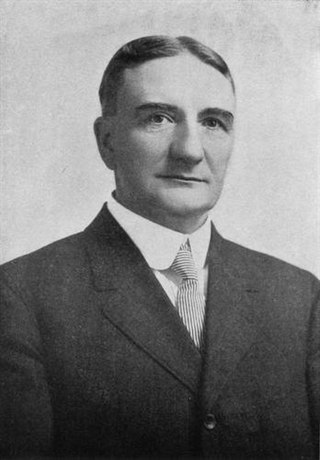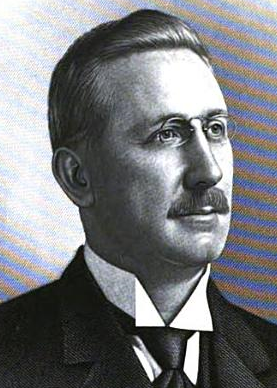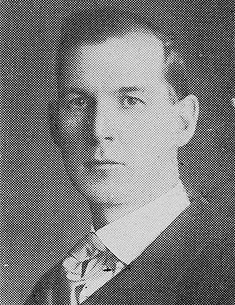
Olin DeWitt Talmadge Johnston was an American politician from the US state of South Carolina. He served as the 98th governor of South Carolina,from 1935 to 1939 and again from 1943 to 1945. He represented the state in the United States Senate from 1945 until his death from pneumonia in Columbia,South Carolina in 1965. He has become infamously remembered for denying clemency to George Stinney,a 14 year-old African American boy who was wrongfully sentenced to death in 1944 after a trial that lasted for one single day,a conviction overturned 70 years later.

The Arthur Ravenel Jr. Bridge is a cable-stayed bridge over the Cooper River in South Carolina,US,connecting downtown Charleston to Mount Pleasant. The bridge has a main span of 1,546 feet (471 m),the third longest among cable-stayed bridges in the Western Hemisphere. It was built using the design–build method and was designed by Parsons Brinckerhoff.

Coleman Livingston Blease was an American politician of the Democratic Party who served as the 89th governor of South Carolina from 1911 to 1915 and represented the state in the United States Senate from 1925 to 1931. Blease was the political heir of Benjamin Tillman. He led a political revolution in South Carolina by building a political base of white textile mill workers from the state's upcountry region. He was notorious for playing on the prejudices of Poor Whites to gain their votes and was an unrepentant white supremacist.

Thomas Lee Woolwine was an American lawyer and politician who served as the 27th District Attorney of Los Angeles County between 1915 and 1923. He began his career as a Deputy District Attorney in 1908. Woolwine was the Democratic nominee for Governor of California in the 1922 general election,but lost to Friend Richardson. In 1923,he resigned as District Attorney and was succeeded by Asa Keyes.

Burnet Rhett Maybank was a three-term US senator,the 99th governor of South Carolina,and mayor of Charleston,South Carolina. He was the first governor from Charleston since the American Civil War (1861-1865) and one of twenty people in United States history to have been elected mayor,governor,and United States senator. During his tenure in the Senate,Maybank was a powerful ally of President Franklin D. Roosevelt. His unexpected death on September 1,1954,from a heart attack,led to Strom Thurmond being elected senator.

William Gaston was a lawyer and politician from Massachusetts. A Democrat,he was the first member of that party to serve as Governor of Massachusetts (1875–1876) after the American Civil War. He was a successful trial lawyer and politically conservative Democrat,who won election as governor after his opponent,Thomas Talbot,vetoed legislation to relax alcohol controls.

Ernest Willard Gibson was an American politician and lawyer from Vermont. A Republican,he served in both the United States House of Representatives (1923-1933) and United States Senate (1933-1940).

Edwin Porch Morrow was an American politician,who served as the 40th Governor of Kentucky from 1919 to 1923. He was the only Republican elected to this office between 1907 and 1927. He championed the typical Republican causes of his day,namely equal rights for African-Americans and the use of force to quell violence. Morrow had been schooled in his party's principles by his father,Thomas Z. Morrow,who was its candidate for governor in 1883,and his uncle,William O. Bradley,who was elected governor in 1895. Both men were founding members of the Republican Party in Kentucky.

Arthur Ravenel Jr. was an American businessman and a Republican politician from Charleston,South Carolina. From 1987 to 1995,he served four terms in the U.S. House of Representatives.

Burton Erwin Sweet was a four-term Republican U.S. Representative from Iowa's 3rd congressional district,then a wide but short chain of counties in north-central and northeastern Iowa,in the shape of a monkey wrench.

The 1909 South Carolina United States Senate election was held on January 26,1909. Its outcome was determined by a Democratic Party primary election held on August 25 and September 8,1908. Interim Senator Frank B. Gary,who had been elected to complete the unfinished term of the late Senator Asbury Latimer,did not run for re-election. Democrat Ellison D. Smith won the Democratic primary and was elected by the General Assembly for a six-year term.
David Burns Hyer was an American architect who practiced in Charleston,South Carolina and Orlando,Florida during the first half of the twentieth century,designing civic buildings in the Neoclassical Revival and Mediterranean Revival styles.

Alfred John Raymond was timber merchant and politician in Brisbane,Queensland,Australia. He was Mayor of Brisbane in 1912.

Albert Wheeler Todd was an architect in Charleston,South Carolina. He is known for his neoclassical architecture,the design on his own home and of a home for Tristram Hyde. Todd was the senior partner at the firm of Todd &Benson which became Todd,Simons &Todd. Joseph F. Leitner worked with him. Todd also served in the legislature from 1910 until 1924 and was a State Senator.

Tristram Tupper Hyde was the mayor of Charleston,South Carolina,from 1915 to 1919.
Thomas Porcher Stoney was the fifty-third mayor of Charleston,South Carolina,serving between 1923 and 1931.

Robert Goodwyn Rhett (1862–1939) was the fiftieth mayor of Charleston,South Carolina,completing two terms from 1903 to 1911. From 1916 to 1918,he served as president of the Chamber of Commerce of the United States.
Jacob Moorer was a South Carolina lawyer and civil rights activist. He frequently fought cases in opposition to the elector provisions of the 1895 South Carolina Constitution,which he viewed as disenfranchising blacks. His most famous case was Franklin v. South Carolina,a murder case involving black sharecropper Pink Franklin which he and John Adams,Sr. appealed to the United States Supreme Court.

John Ignatius Fitzgerald was an American attorney who served in the Massachusetts General Court and on the Boston City Council. He was the Democratic nominee for the United States Senate in 1948.
















